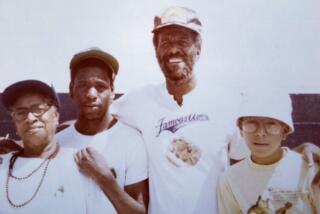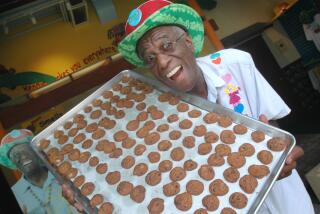Cover Story : DOUBLE WHAMMY! : Wham-O’s San Gabriel headquarters was once a rollicking joint full of Hula Hoops, Frisbees--and employees. Then the company was sold and most of the jobs went elsewhere. Now, uncertainty looms as a new owner takes over. But oh, the memories.
- Share via
Oh, how the place once shook and shimmied, wobbled and whirled, this twinkling toy factory that turned out Whing Dings and Nutty Knotters and Zip Zaps.
Together, two new USC grads, Rich Knerr and Arthur (Spud) Melin, dreamed up this whimsical place called Wham-O in 1948; two wacky best friends who once got arrested in Pasadena for hurling rotten oranges at each other as teen-agers.
Together, they began a mail-order business by making 75-cent slingshots in the Knerr family garage, then moved on to ship a pirate’s treasure chest worth of toys around the world--Silly String, Slip ‘N Slides, Frisbees and dozens more--from the company’s San Gabriel complex.
Together, they masterminded a ring of plastic called the Hula Hoop, the world’s ultimate rock ‘n’ roll toy of the late ‘50s, a hip-wiggling invention that exploded onto the scene at a time when TV cameras shot Elvis from the waist up. Oh, how Knerr and Melin miss the Hula Hoop’s heyday, when the world came calling.
“The whole world went crazy with Hula Hoop,” recalled Knerr, now a 68-year-old Arcadia resident.
“They called us the ‘Fun House.’ We acted kind of nutty on purpose,” said Melin, a 69-year-old Irvine resident.
But their improbable story--one of two local boys who made history--is all but forgotten.
Indeed, Wham-O’s story is shoved aside in the recently released Hollywood movie “The Hudsucker Proxy,” a fictional account of the Hula Hoop’s making, starring Tim Robbins and Paul Newman. The story is a dark one, about how a corporate board’s scheme to ruin Hudsucker Industries is thwarted by the company’s invention of the wildly popular Hula Hoop.
It is a bittersweet juncture for Wham-O--just when Hollywood is making the Hula Hoop a shining star again, the company’s spotlight continues to fade, almost to black. On May 31, Mattel Inc. takes over when it closes a deal to buy Kransco, Wham-O’s parent company. Mattel, the country’s largest toy maker, is not saying what changes, if any, are in store for Wham-O.
Knerr and Melin, who retired 12 years ago and are still best friends, say little about Mattel, only that the pairing looks to be a good match. Publicly, Wham-O employees say they do not know what to expect from Mattel; privately, they worry that the new owner will shut down their offices and reassign operations to one of Mattel’s Southern California plants.
Already, Wham-O’s San Gabriel complex--which made and shipped 100 million Hula Hoops in the first 16 months of the toy’s introduction--mostly handles administrative duties for its parent company; no toys are made or invented there anymore. Now, the possibility looms that the Wham-O complex will disappear.
Over the years, Wham-O has shrunk like an image in a fun house mirror. A skeleton crew of 20--down from more than 1,000--runs the once-bustling company. Now, Wham-O’s 171,000-square-foot complex and its eight buildings are as quiet as a tired big top, with suite after suite of abandoned offices and warehouses so empty that you could fling a Frisbee from end to end without hitting a thing.
It’s eerie all right, the stillness of a place that once buzzed with the whiz of shrink-wrap machines and the glee of Knerr and Melin at play, shooting each other with Air Blaster toy guns and plotting practical jokes, such as the time when Knerr shipped a baby elephant to his partner’s wife in San Gabriel.
“Very sad,” Melin said. “(Wham-O) just went down to almost nothing.”
*
“Now when you go out there, there’s zero, OK?” said plant manager Larry Frazier, a 26-year employee, sadly spreading his empty hands.
Wham-O’s transformation began in 1982, when Knerr and Melin decided to retire and sell the company to Kransco for $12 million. Within five years, the San Francisco-based toy and sporting goods manufacturer shifted most of Wham-O’s production to Mexico, laid off all but a few of the 300 full-time staff members, and stopped hiring the 300 to 500 temporary workers who came aboard during the busy season.
In the old days, Wham-O created and shipped 40 to 50 products a year; now, the San Gabriel warehouse sends out only three Wham-O products--the Hula Hoop, Frisbee and Hacky Sack--that are made elsewhere and then shipped in for distribution. Wham-O stopped making toys in San Gabriel more than 10 years ago.
More than three decades after the Hula Hoop craze, Wham-O’s office staff works on promotions, advertising and product development for Kransco, which makes Hula Hoops in Virginia Beach and Frisbees in Mexico. The staff still works out of Wham-O’s aging original buildings, with stained carpet and worn linoleum.
But oh, what a place it was, started by two buddies who believed in a plastic tube in bright colors and ignored the scuttlebutt that said no, sir, you can’t sell a rinky-dink garden hose for three bucks. But the colorful hoops turned into an overnight sensation, creating such hysteria that the Japanese police banned the “Hura Hoopu” from Tokyo streets.
In the Hula Hoop’s heyday in the late ‘50s, workers cranked out 20,000 Hula Hoops a day in Johannesburg, Tokyo, Paris and five other plants; in San Gabriel, supervisors set up production lines in the warehouse, the parking lot, the hallways, wherever there was room.
It was a time of endless madness, a toy so famous that it is displayed in the Smithsonian Institution and listed in Webster’s dictionaries. Following the credits for “The Hudsucker Proxy,” a disclaimer says that the Hula Hoop actually was invented by Wham-O’s founders, “a true American success story.”
This is the real story, of how the world fell in love with Wham-O.
*
Wham-O’s founders grew up as two playful boys, always scheming, little entrepreneurs to the bone. At age 9, Knerr made rubber band guns out of wooden apple crates and clothespins, hawking them to kids on his street in South Pasadena. Melin grew up in Pasadena; at age 10, during summer vacations in Newport Beach, he turned into a mega-fisherman--he rigged up a clothesline over part of Balboa Bay, attached 50 hooks with bait and collected the morning’s catch by rowboat. Then he loaded his red wagon with ice and sold fresh halibut and bass door to door.
The two hit it off when they met as teen-agers, kindred spirits. After college, neither wanted to work for his father--Knerr’s dad was in industrial real estate, Melin’s in the lumber business. They decided to sell their homemade slingshots after their barber suggested that there might be a few bucks in it.
In 1948, the two buddies started a little sporting goods company, moving from the Knerr family garage to a rented space in Alhambra. They made the slingshots, hunting knives and crossbows with a band saw they bought from Sears for a $7 down payment. They came up with the company’s name, based on the sound of a slingshot hitting its target--Sling-O? Slam-O? How about Wham- O? Within a few years, their mail-order business was pulling in about $100,000 a year, enough for the partners to buy their first building in San Gabriel.
Neither partner fancied himself a toy maker. Until one day, when they took a chance on a simple piece of plastic that skimmed the air like a flying saucer.
*
It happened on the beach one day when a fellow and his flying disc caught their eye. The disc player, Fred Morrison, called his invention the “Pluto Platter” and agreed to sell it to Wham-O. Knerr and Melin renamed the disc after a funny cartoon character. Afterward, the two marketing whizzes just winked when the curious asked if the Frisbee worked via invisible string. In 1957, they put out their first toy, the Frisbee, and took their first turn down the road to fame.
The next year, a friend told them that they ought to see the bamboo rings that Australian kids twirled in exercise class. So, without seeing the Australian version, Knerr and Melin decided to fiddle with a hoop of their own that they made of ash wood and bound with rawhide. They asked a visiting Australian toy maker to show them how the hoop worked, but the guy only could only manage a whirl or two before it fell at his feet.
But one Saturday in the office, Wham-O’s 22-year-old research and development engineer picked up the hoop and got it twirling around his waist like crazy. The engineer, Dick Gillespie, was on to something, and the partners knew it.
“Everyone just fell off their chairs, they couldn’t believe it,” said Gillespie, 58, a San Gabriel resident.
The partners set out to find the right material for the hoop--something that swung soft on the body. The wood wasn’t right, so they decided to go with plastic, a substance that had then just recently come into popular use and it was lighter and more flexible. Then the name--Twirl-a-Hoop? Swing-a-Hoop? How about Hula Hoop?
The madness began.
Knerr and Melin tested the hoop on local schoolchildren; one of the Hula Hoop’s first trial runs was at a Pasadena elementary school in the summer of 1958. They told the students: You master the hoop, and it’s yours. Oh, how the faces of the children lit up when they got the hang of it.
Soon, they improvised by twirling the hoop around their necks, then their feet, defying gravity and social conventions at the same time. Even Gillespie’s wife, who told him that the hoop action looked “nasty,” got hooked and, three months later, climbed on a table in New York to demonstrate the toy in front of industry buyers.
*
In the toy industry, skeptics scoffed and then ate their words. Consider the bigwig New York City toy distributor who looked down his nose at a 22-year-old Gillespie, peddling a colored piece of plastic. No thanks, said the bigwig, eating his Danish pastry off a linen napkin. But a month and a half later, the bigwig showed up at Wham-O’s New Jersey plant, rolled up his suit sleeves and helped load trucks so that the Hula Hoop would get to his distributors on time.
The Hula Hoop craze died down in the early ‘60s, almost as quickly as it had started, but by then, Wham-O was on a roll. The company had one tiger by the tail in the Hula Hoop and kept looking for others. In the 1960s and ‘70s, Wham-O put out dozens of toys, whatever caught the partners’ fancy. Half the fun was in the toy’s name, which rolled off the tongue and packed a punch in the parlance of super-hero comic book speak: Super Elastic Bubble Plastic. Shrink Machine. The Bubble Thing.
*
But Wham-O took the fun business seriously. Factory workers puffed out their chests when they saw the way the world took to the Hula Hoops and Frisbees that they made, former assembly worker June Brisley said.
Everywhere Brisley turned, she saw kids playing with Wham-O toys. One night, on a family vacation in Seattle, she marched over to talk to picnickers who were throwing glow-in-the-dark Frisbees that looked like flying moons. “I made this,” she said.
“We were so proud,” said Brisley, a 66-year-old San Dimas resident who arranges Wham-O reunions twice a year. “We packed Hula Hoops, three dozen to a box, red, pink, yellow, packing, packing, packing . . . making a whole bunch of toys, making kids happy.”
That was the kind of place that Knerr and Melin built; everyone called them “Rich and Spud.” No fancy high-powered ad agencies or focus groups--Wham-O tested toys on the children of employees and filmed commercials in Knerr or Melin’s back yard.
The two partners hated to sit behind a desk. In the office, they put money on who could throw a Super Ball--a Wham-O plastic ball with legendary bounce--into a wastebasket in a certain number of bounces. They took breaks outside, shooting darts into the wood side of a liquor store or picking Frisbee targets. Someone picked a target--a car door, for instance--and then the other person picked a farther target until they ended up blocks away.
“I miss it all the time,” said Melin, who still throws his Frisbee over the ocean with reverse spin so that it arches right back into the hands of its maker.
“I think if Spud and I had to say what we contributed, it was fun,” said Knerr, whose wife still cannot get him out of a toy store. “But I think this country gave us more than we gave it. It gave us the opportunity to do it.”
And they did it with style, in a place where employees felt loose enough to sneak up on the two partners one day and douse them with Silly String.
“It was really humming, I’m telling you,” said Carmelita Mata, 79, a former assembly line worker.
Frazier, the plant manager, knows every square inch of the Wham-O buildings, where managers used to watch for bad batches of glue, where sealing machines hot-stamped Frisbees with Wham-O’s candy-cane red-and-white logo, where a railroad spur allowed trains to whisk away products directly from assembly lines.
One afternoon, Frazier headed for the company’s makeshift archive, a cinder-block tomb of sorts for forgotten toys, ghosts of Wham-O’s past. The archive is the old warehouse tool crib.
From a rusty tool shelf, Frazier picked up a box of the Super Balloon--an inflatable 10-foot-long skinny balloon--and unfolded the product carefully.
“Some of these are just old, old, old, old, old, old,” he muttered.
But old habits die hard--Frisbees and Hula Hoops are still going strong, although Kransco will not release sales figures.
Neither Knerr nor Melin talks about the old days much; each is likely to change the subject when asked. Knerr has no plans to see Hollywood’s version of the Hula Hoop story.
“It’s a farce,” he shrugged.
He speaks briskly about the Wham-O days and asks a reporter who interviews him: “This won’t take long, will it?” Sure, he misses the place but, he says with a chuckle: “I don’t think I want to go back to work again.”
Melin is more the raconteur, given to long-winded stories. He saw “The Hudsucker Proxy” and liked it, although he thought actor Tim Robbins needed a little work on his hip action.
*
“They’re making a story that isn’t true, and it may hurt other entrepreneurs,” he said.
He tends to downplay Wham-O’s mark on the world, calling it “just a little company.” But he owns up that he taught four of his dogs to catch Frisbees in flight. And at 5 feet, 10 inches and 145 pounds, he can still keep a Hula Hoop going.
Melin doesn’t play favorites, but the truth be told, he has a soft spot for Frisbee.
“It’ll always be around,” he said confidently.
Oh, how that Frisbee took off.
“How could just a piece of plastic like that do so good? If we were on a desert island, that’s the best thing you could have. Especially if the breeze is going good. You can throw it over the ocean, and it’ll come right back to you, if you throw it just right.”
WHAM-O’S WORLD Frisbees
* Ivy League students started experimenting with flying discs in the 1920s, when they tossed around pie tins from the Frisbie Baking Co. of Bridgeport, Conn., though that’s not where the toy got its name.
* Fred Morrison, son of the inventor of the automobile sealed beam headlight, combined his interest in flight and a new post-World War II substance called plastic to form the flying disc.
* In 1968, the Navy spent nearly $400,000 to test Frisbee discs as a vehicle for keeping flares aloft, but the idea never took off.
Hula Hoops
* Within four months of the Hula Hoop’s introduction in 1958, more than 20 million were sold.
* In 1958, the Hula Hoop retailed for less than $3; now, it sells for about $4.
* If the plastic tubing for all Hula Hoops were placed end to end, the tube would circle the Equator more than five times.
Other Wham-O Products
* Girls who wrapped themselves in Silly String found out that it did not come out of their hair as easily as the directions said.
* In the early 1960s, Norman Stingley, a chemical engineer, accidentally created a plastic product that bounced uncontrollably. Wham-O bought the product and created the Super Ball.
The Ones You Never Heard Of
* In the 1960s, during Cold War fever, Wham-O sold a $119 do-it-yourself bomb shelter. It bombed.
* When the movie “Jaws” came out in 1975, Wham-O rode the wave of popularity and created plastic great white shark teeth. A few sold before they sank out of sight.
More to Read
Inside the business of entertainment
The Wide Shot brings you news, analysis and insights on everything from streaming wars to production — and what it all means for the future.
You may occasionally receive promotional content from the Los Angeles Times.










